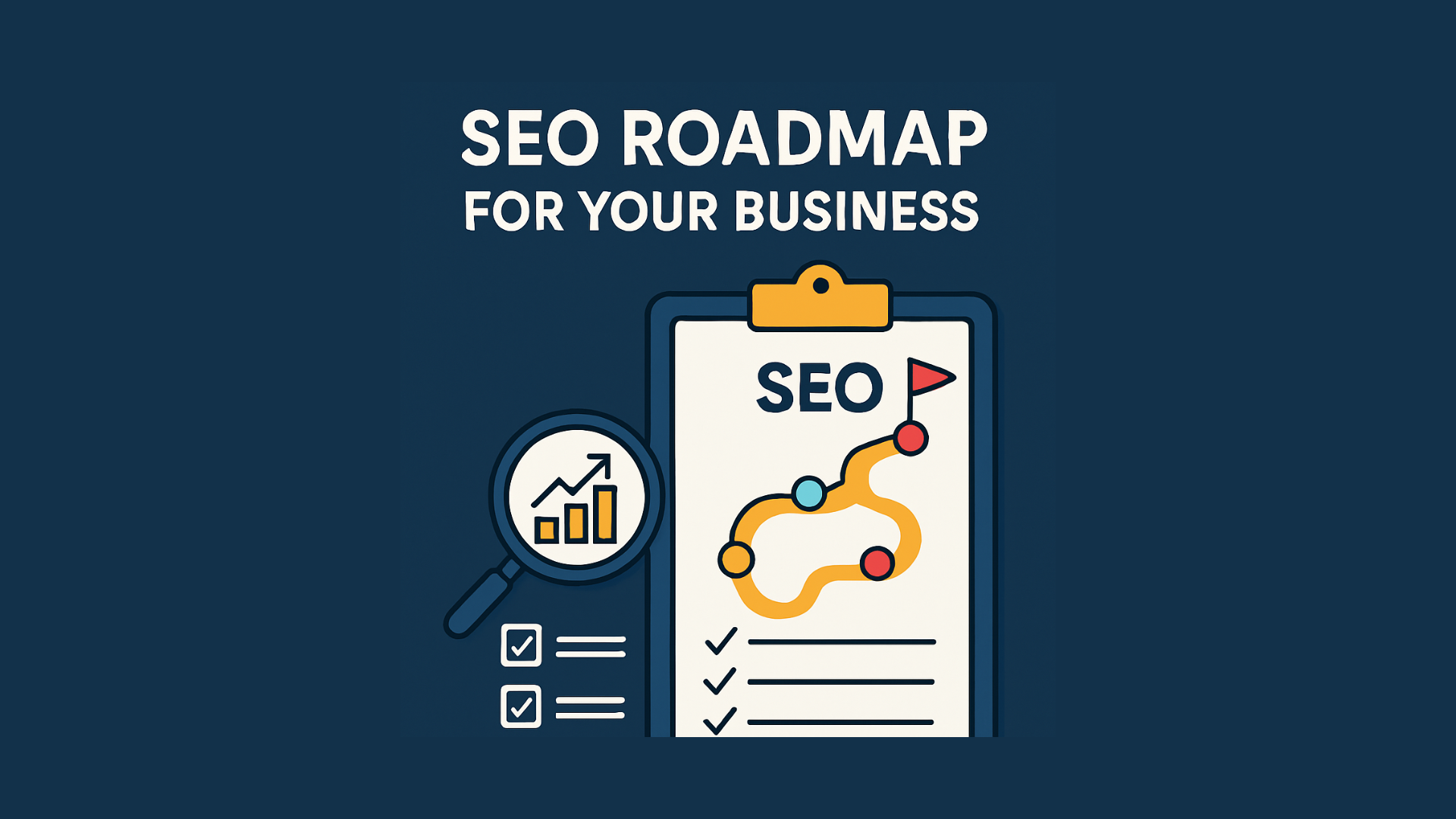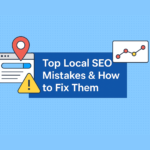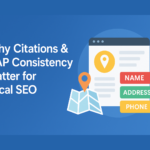- August 6, 2025
- Categories: SEO
- Tags:
How to Create an Effective SEO Roadmap for Your Business
Creating a successful SEO strategy isn’t about throwing keywords into content and hoping for the best. It’s about having a well-structured, data-driven roadmap that aligns with your business goals. Whether you’re a startup or an established brand, an effective SEO roadmap helps you stay focused, prioritize actions, and measure success over time.
In this blog, we’ll walk you through everything you need to build a practical and scalable SEO roadmap for your business.
What is an SEO Roadmap?
An SEO roadmap is a step-by-step action plan designed to improve your website’s organic visibility in search engines. It outlines the technical, content, and backlink strategies you’ll implement over weeks or months along with clear timelines, responsibilities, and measurable KPIs.
It helps you:
- Set realistic goals
- Organize and prioritize SEO tasks
- Track progress and make data-driven decisions
- Align SEO with your broader marketing objectives
Why Your Business Needs an SEO Roadmap
Without a roadmap, SEO becomes reactive. You might fix errors here and there or publish content randomly without direction. A roadmap ensures that:
- Your team is aligned on priorities
- Budgets and resources are used effectively
- You’re consistently improving SEO performance over time
For businesses targeting competitive markets, a roadmap is not optional, it’s essential.
Step-by-Step Guide to Creating an SEO Roadmap
1. Conduct a Website Audit
Start by thoroughly assessing the current health of your website using a combination of reliable tools such as Google Search Console, Screaming Frog, SEMrush or Ahrefs, and GTmetrix or Google PageSpeed Insights. This audit should uncover a range of issues that may be hurting your organic performance. Look for technical problems like broken links, crawl errors, and mobile usability challenges.
Analyze your on-page optimization to find gaps in title tags, meta descriptions, and headings. Evaluate the overall quality of your content, flag any duplication, and assess whether your pages meet Google’s standards for relevance and clarity. Pay special attention to page speed metrics and Core Web Vitals, as these directly impact rankings and user experience. Finally, compare indexed versus non-indexed pages to ensure your most valuable content is discoverable. This foundational audit will help you pinpoint both quick wins and critical blockers that need attention in your SEO roadmap.
2. Define Clear SEO Goals and KPIs
Before diving into tactics, set precise and measurable objectives to guide your SEO efforts. Examples of effective goals include increasing organic traffic by 30% within six months, ranking in the top three positions for 10 of your core keywords, improving your domain authority score to 40 or higher, and increasing conversions from organic visitors by at least 15%. It’s crucial that your KPIs are tied to broader business metrics such as revenue growth and lead generation rather than vanity metrics alone. These goals will not only give your team clear targets but will also make it easier to measure success and justify ongoing investment in SEO.
3. Perform Keyword Research
Next, conduct in-depth keyword research using tools like Google Keyword Planner, Ahrefs, or Ubersuggest. Identify high-volume, low-competition keywords relevant to your products or services, as well as long-tail keywords that capture specific buying intent. If your business targets certain geographic areas, include localized terms to attract regional audiences. Incorporate question-based keywords to fuel blog content and capture informational queries. Once you’ve gathered your list, group keywords into categories: primary keywords for main service and product pages, supporting keywords for blogs and guides, and LSI (Latent Semantic Indexing) keywords to strengthen the semantic relevance of your content. This keyword foundation will inform nearly every aspect of your SEO strategy.
4. Segment Your SEO Tasks
Break your SEO activities into four core areas to maintain clarity and focus:
- Technical SEO: Resolve crawl errors, redirect broken pages, and improve your site’s mobile responsiveness. Confirm that your site is secure with HTTPS, uses canonical URLs to prevent duplicate content issues, and has an up-to-date XML sitemap. Optimize your load speeds and ensure you’re meeting Google’s Core Web Vitals benchmarks.
- On-Page SEO: Optimize title tags and meta descriptions for primary keywords while maintaining readability. Use a clear heading hierarchy from H1 to H6, and enhance internal linking with descriptive anchor text. Make sure all images are compressed and tagged with relevant alt text, and include schema markup to help search engines understand your content.
- Content Strategy: Audit your existing content library to see what’s performing and what needs updating. Refresh outdated pieces, add new landing pages for important products or services, and create blog posts around your keyword clusters. Consider developing pillar pages that anchor related content into cohesive topic clusters.
- Off-Page SEO: Plan how you’ll earn high-quality backlinks. Identify reputable sites for guest posting opportunities and build citations to support local SEO. Use tools to regularly monitor your backlink profile and disavow toxic links if needed.
5. Build a Content Calendar
Leverage your keyword research to develop a content calendar that spans at least three to six months. Schedule blog articles targeting informational and long-tail keywords to drive traffic at every stage of the customer journey. Include service pages optimized for transactional searches and publish case studies, client success stories, and FAQs to build trust and authority. Use project management tools like Trello, Notion, or Google Sheets to assign tasks, set deadlines, and track progress on each piece of content.
6. Map Your Timeline
Create a realistic timeline that outlines when each SEO activity will occur. For example:
- Months 1–2: Prioritize technical fixes and core on-page optimizations.
- Months 3–4: Focus on expanding your content and launching backlink-building campaigns.
- Months 5–6: Refine your strategy using performance data and implement advanced tactics such as schema updates and content re-optimization.
Assign clear task owners and deadlines for each phase to ensure accountability and consistent progress toward your goals.
7. Track Performance and Adjust
Ongoing measurement is essential to keep your SEO roadmap on course. Use Google Analytics and Search Console alongside your preferred SEO tools to monitor trends in organic traffic, keyword rankings, bounce rates, dwell time, conversions, and backlink profile growth. Review these metrics monthly and conduct a deeper evaluation every quarter. Use your findings to refine your strategy, double down on tactics that are working and revise or replace those that aren’t delivering results.
Common Mistakes to Avoid
- Lack of focus: Trying to rank for too many unrelated keywords
- One-time execution: SEO is not “set and forget”
- Ignoring user intent: Optimizing content without understanding what users want
- No internal alignment: SEO efforts not coordinated with content or development teams
- Skipping technical SEO: Ignoring site speed, crawlability, or mobile usability
Creating an SEO roadmap isn’t just a best practice, it’s the foundation for long-term, consistent success. Whether you’re running an e-commerce store, local business, or digital agency, a structured SEO plan ensures that your resources are spent wisely and your goals are met strategically.
If you need help creating or executing your SEO roadmap, VP Advertising can guide you through every stage from audit to execution and reporting.





BM REALITY GROUP
August 11, 2025Thanks for sharing this information